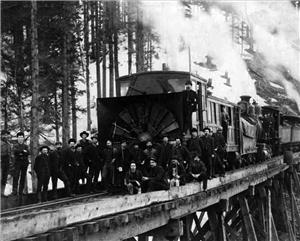Virgil G. Bogue (1846-1916), along with James Gregg, Andy Drury, and Mattew Champion, discover the pass through the Cascade Mountains, later called Stampede Pass, after a grueling survey trip up the Green River from Tacoma. They are conducting the survey for the Northern Pacific Railroad. Although the Northern Pacific will not complete the Cascade Division of the transcontinental into Tacoma until 1888, this discovery convinces Tacomans that it will, actually, be built.
Finding the Lowest Point
Bogue described the actual discovery:
“Starting early on March 19th, with our route for the morning at least settled upon, and with favoring skies that lighted our hearts, we made excellent progress. A little after nine o’clock appeared a sharp bend in the ridge to the north, as anticipated. We descended along a well-defined crest so rapidly that in less than an hour the barometer marked only 3,495 feet elevation at a point where for a little distance about us there were no trees. It was evidently one of the lowest points of the divide” (Morgan, 199).
Finding the Way Through
Civil engineer Virgil Gay Bogue began working for the Northern Pacific in 1880. He was sent to Tacoma from Eastern Washington, arriving on December 27, 1880, and given instructions to “assemble a survey party with all possible speed, ascend the Green River to its headwaters, and locate a pass for rails through the Cascade barrier” (Morgan, 195).
Bogue was experienced with mountains, having spent the previous decade working in the Andes. Surveying the Green River up into the Cascades in mid-winter, however, was a grueling assignment and finding the pass, which the company named Garfield Pass after the president of the United States at the time, was one of the last major surveying adventures in the building of the second transcontinental rail line authorized by the U.S. Congress across the continent, the Northern Pacific Railroad.
Finding the pass did not lead to immediate construction. Henry Villard (1835-1900) took over the Northern Pacific in September 1881, and he wanted the terminus to remain in Portland, Oregon. It was not until 1884, when Robert Harris (1830-1894) became president of the Northern Pacific, that construction of the Cascade Division became possible, and not until 1885 that Harris decided it was essential to rush construction of the Cascade Division.
By that time it was clear that the pass was higher than Bogue had measured -- 700 feet higher than Snoqualmie Pass just to the north. Harris, however, was convinced that the terminus should be at Tacoma and Stampede Pass came through the mountains directly east of Tacoma. A tunnel would have to be built. On May 3, 1888, the tunnel was bored through, and the Northern Pacific was, finally, complete.
Stampede Camp
The name “Stampede Pass” is somewhat obscure and there are many stories, but the general opinion seems to be that when Bogue’s men were cutting trails a few weeks after the pass was discovered, Bogue became dissatisfied with a group of workers camped a few hundred yards below the pass.
“He dispatched a foreman notorious as a slave-driver to get some work out of them. The foreman showed up, and the men threw down their tools, rolled up their blankets, and took off for Tacoma, all except young Johnny Bradley of Puyallup. . . When a new crew arrived they found he had nailed a board to a tree and printer on it, in pencil, ‘Stampede Camp.’ Usage transformed the name to the little lake nearby, then to the pass. Stampede Pass it still is” (Morgan, 200).
Bogue continued to work for the Northern Pacific until the Cascade Division was completed, primarily in Eastern Washington. Stampede Pass (with the Stampede Tunnel) was the mainline for the Northern Pacific Railroad for decades and has been improved recently for freight use.

